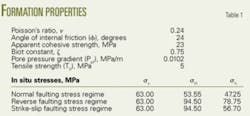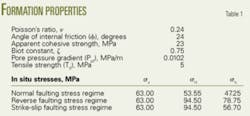Critical Mud Weight-Conclusion: Analysis identifies safe mud weights for horizontal wells
For drilling horizontal wells in a typical formation in Saudi Arabia, a sensitivity analysis delineates the boundaries for safe mud weights as a function of different formation stress regimes, well orientation, and depth.
This analysis is based on the proposed simplified analytical method discussed in Part 1 (OGJ, Oct. 3, 2005, p. 36) of this two-part series. Both well orientation and the prevailing stress regime are main factors that influence the critical mud weight, above which a formation may fracture and below which a wellbore may collapse.
Stress redistribution
Rotary drilling disturbs the original equilibrium of in situ stresses because the formation surrounding the wellbore has to bear the part of load previously supported by the removed rock. Also the pressure exerted by the drilling mud, wellbore inclination and orientation, wellbore exposure time to the mud, surge and swab pressure, etc. can affect the stress distribution around the wellbore.
This stress redistribution, when it exceeds the formation strength, may cause unstable hole conditions, which in turn may result in different modes of failures, namely shear or tensile failures. These failure criteria are functions of different parameters related to mechanical properties of the rock, formation characteristics, pore pressure, prevailing in situ stresses, hole inclination, wellbore mud pressure, and hole orientation with respect to the direction of maximum horizontal in situ stress.
In general, mud weight influences all of these failures because it directly correlates with the pressure in the wellbore.
Case study
A sensitivity analysis for a horizontal well drilled in a formation in Saudi Arabia illustrates the factors influencing the mud weight. The factors considered include:
• Stress regimes based on geological fault systems.
• Horizontal well orientation with respect to the direction of maximum horizontal stress or azimuth.
• Well depth.
The analysis establishes the applicability of the proposed model and provides the general guideline for predicting mud pressure for drilling the horizontal well, mechanical properties of the well, in situ principal stresses, and reservoir pore pressure.
Mohr’s and Coulomb’s theories are often used to define geological fault systems on the basis of shear failure. Faults are classified according to the relative magnitudes of principal stresses, which are the vertical in situ stress (σv), maximum horizontal in situ stress (σH), and minimum horizontal stress (σh). The stress regime for these faults consists of as follows:
• Normal faulting (σv > σH > σh). In normal faults, the vertical in situ stress is the maximum principal stress and the minimum horizontal stress is the minimum principal stress.
• Strike-slip faulting (σH > σv > σh). In strike-slip faults, the maximum principal stress is the maximum horizontal in situ stress and minimum principal stress is the minimum horizontal stress.
• Reverse faulting (σH > σh > σv). In reverse faulting, the stress regime is the opposite to the normal faulting stress regime, in that the vertical in situ stress is the minimum principal stress and the maximum in situ horizontal stress is the maximum principal stress.1
In this case study, the horizontal well is oriented with respect to the direction of maximum horizontal stress. This orientation is defined as azimuth β. When β = 0°, the wellbore is parallel to the direction of maximum horizontal in situ stress. When β = 90°, the wellbore is parallel to the direction of minimum horizontal in-situ stress.
Table 1 lists the mechanical properties and the corresponding stress data of a typical formation drilled in Saudi Arabia. These values are from a study by Al-Awad.2
Analysis
The analysis, with analytical equations discussed in Part 1 of this series, calculates the lower and upper wellbore pressure (Pw, lower and Pw, upper) exerted by the drilling mud. Note that Pw, lower and Pw, upper are the critical mud pressures or the limiting mud pressures beyond which the wellbore will become unstable and potentially result in either a collapsed wellbore or a fractured formation (Fig. 1).
The mud pressure must be in a range within this boundary for a given set of parameters that include magnitude and orientation of in situ principal stresses, rock mechanical properties, and reservoir pore pressure, well depth, and wellbore orientation with respect to maximum or minimum principal stress.
Fig. 1 plots the upper and lower wellbore boundary pressures as a function of the horizontal wellbore orientation (azimuth) with respect to the maximum horizontal stress (σH) direction for the three faulting stress regimes for wells at 3,050-m depth.
In normal faulting (Fig. 1a), the Pw, lower varies almost linearly with the wellbore orientation with respect to the σH direction at the given depth. The magnitude of Pw, lower increases slightly as the wellbore azimuth moves from 0° to 90°, while Pw, upper decreases as it moves from 0° to 90°.
In the normal faulting stress regime, the margin of the mud pressure within the safe range is greater while the horizontal well is drilled parallel to the direction of σH, and it decreases when the well moves towards the direction of σh. This margin, however, also decreases with increasing well depth (Fig. 2a).
In addition, the Pw, lower increases both with wellbore orientation and well depth, and Pw, upper shows the reverse trends from the normal faulting stress regimes (Fig. 2a).
In reverse faulting stress regimes, the variation of Pw, lower and Pw, upper with respect to the wellbore orientation at 3,050 m follows the trend similar to the normal faulting stress regime (Fig. 1b). The magnitudes, however, are greater compared with the normal faulting stress regime.
The Pw, lower increases at greater well depths and wellbore deviation from the σH stress direction (Fig. 2b). The variation of Pw, upper is non-linear and it decreases at greater and shallower depths (Fig. 2b). This indicates that the reverse faulting stress regime has an optimum depth for a given set of rock properties and stress systems. The margin between the Pw, lower and Pw, upper is greater for a given orientation of the wellbore.
For the set of parameters considered in this study, at about 4,500-m depth, the range of safe mud pressure is about 50-190 MPa when the wellbore is aligned with the σH direction (Fig. 2b). This limiting range changes to about 60-180 MPa at a 6,000-m depth. The limiting value, however, is much less in the normal faulting stress regime.
The strike-slip stress regime shows the non-linear nature of Pw, lower and Pw, upperwith wellbore orientation and depth (Fig. 1c). In general, for the strike-slip faulting stress regime, the margin between Pw, lower and Pw, upper decreases with increasing the wellbore deviation orientation with respect to the σH direction as well as with depth (Fig. 2c).
Moreover, the limiting value of Pw, lower and Pw, upper is much greater compared to both normal and reverse faulting stress regimes. This implies that controlling mud weight is necessary for drilling a horizontal well in a strike-slip faulting stress regime, especially when the well is aligned with the σh stress direction at deeper depths.
In both reverse and strike-slip faulting stress regimes, drilling a horizontal lateral requires greater mud pressure compared with a normal faulting stress regime. For the data in this case study, the required lower and upper boundary mud weight are on average about five times greater in reverse and strike-slip faulting regime compared with the normal faulting stress regime, especially for a horizontal well drilled parallel to the direction of maximum in-situ horizontal stress.✦
References
1. Hossain, M.M., Rahman, M.K., and Rahman, S.S., ‘’Hydraulic Fracture Initiation and Propagation: Roles of Wellbore Trajectory, Perforation and Stress Regimes,” Journal of Petroleum Science and Engineering, Vol. 27 (2000), pp. 129-149.
2. Al-Awad, M.N., “Investigation of Affecting The Stability of Horizontal Oil and Gas Wells,” SPE-Saudi Aramco Chapter Technical Symposium, Dhahran, June 8-10, 1997.



